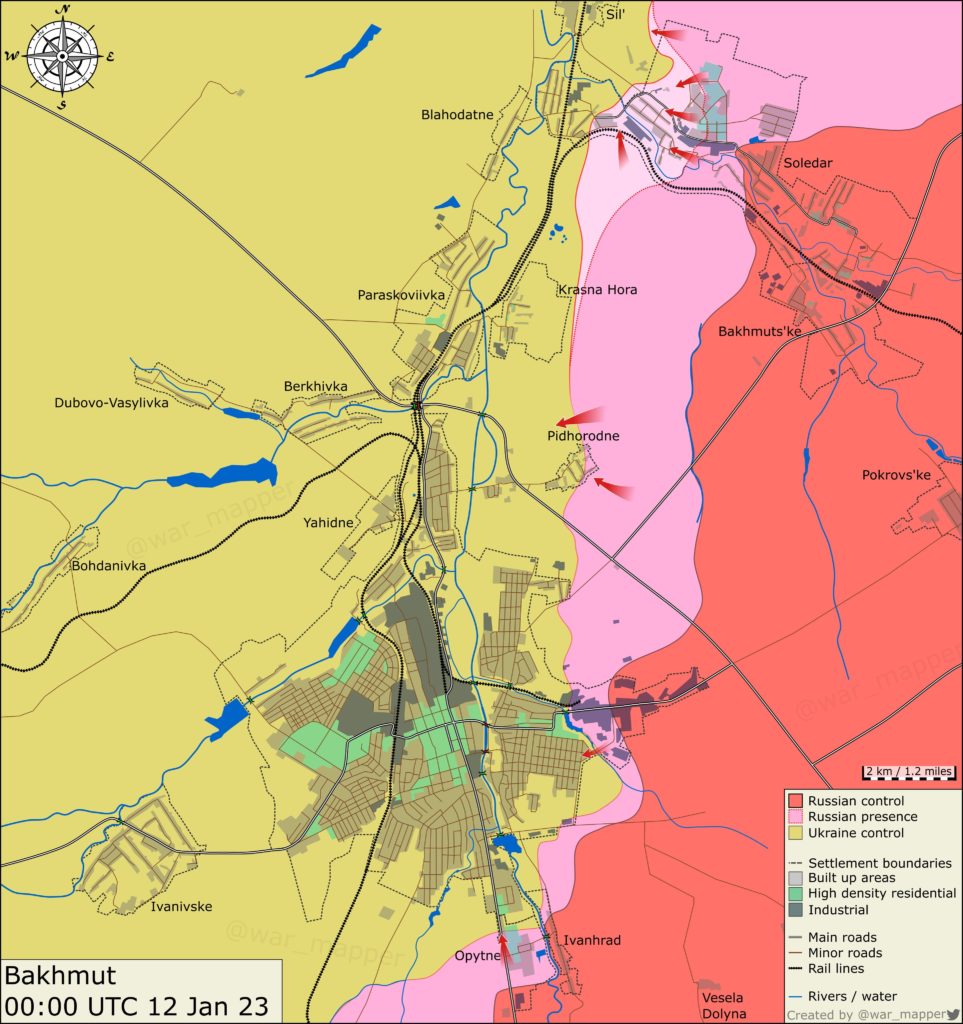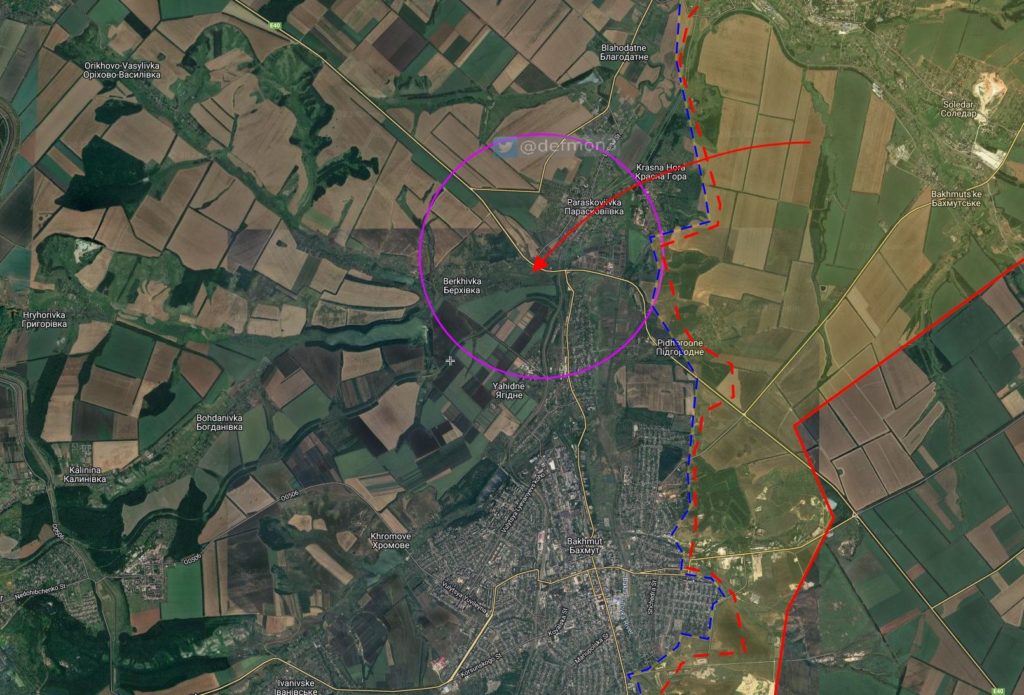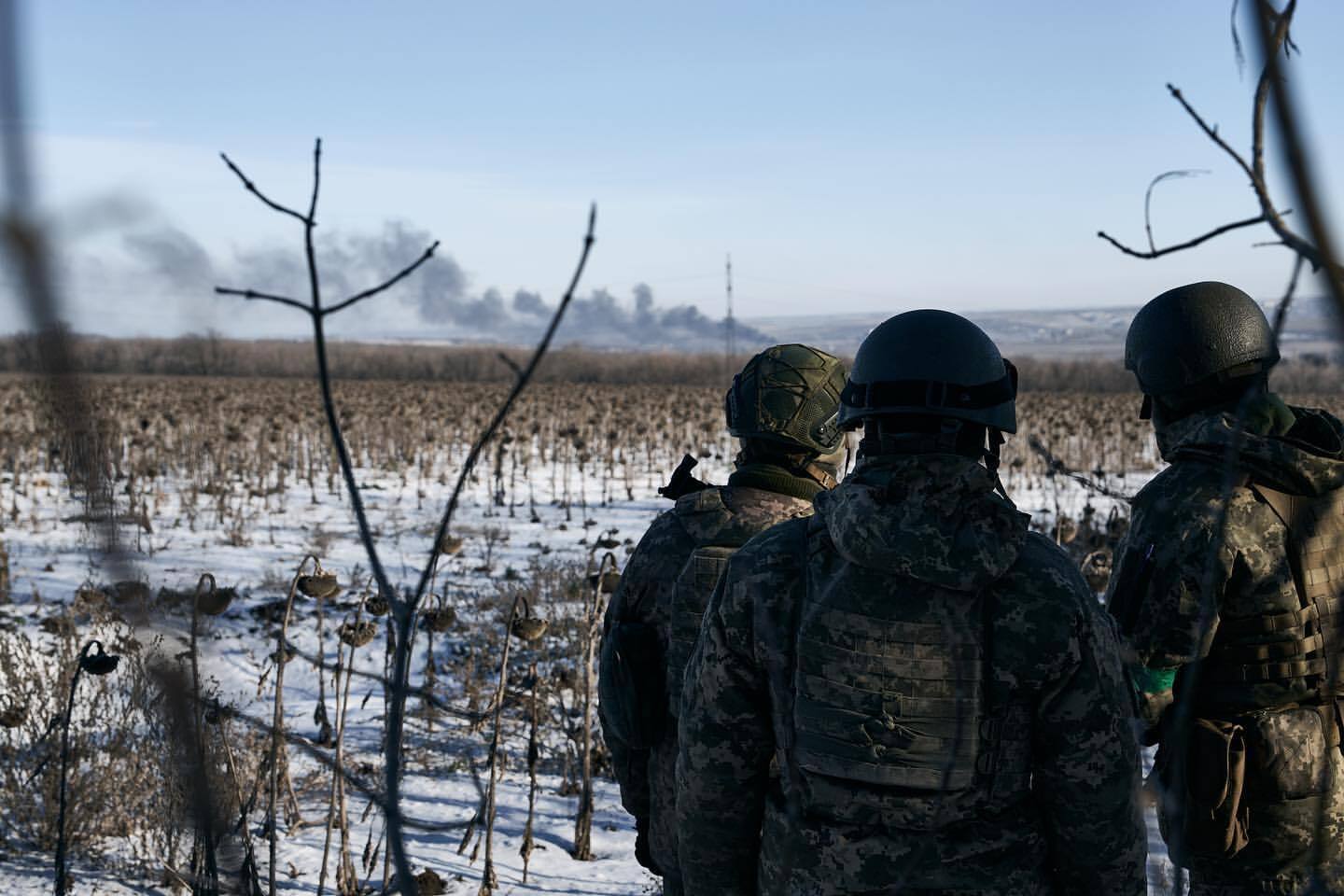Soledar, a small town of Donetsk Oblast in eastern Ukraine, has become the hottest spot on the war map over the past two weeks. Russian indiscriminate shelling has razed most of the city to the ground, turning it into a ghost town with an apocalyptic lunar landscape and obliterated neighborhoods.
Before the Russian invasion, there were around 10,000 inhabitants in Soledar. Now only 523 residents are left in the town, according to Pavlo Kyrylenko, the head of Donetsk Oblast Military Administration. Civilians are stuck amid the ruins with no way out, while the heaviest fighting rages in their hometown. All evacuation routes are currently cut off by non-stop Russian artillery fire.
Russian Offensive Against Soledar in Full Swing
Soledar is located some ten kilometers northeast of Bakhmut, which Russia still fails to capture after more than five months of intense battle. The situation in and around Soledar is currently unclear, being obscured by the fog of war. Positions are changing hands constantly.
Russian forces strive to capture Soledar in order to envelop Bakhmut from the north and disrupt Ukrainian ground lines of communication (GLOCs), according to British Intelligence. Thus, Russian attacks on Soledar are closely connected to the battle of Bakhmut.
Currently, Ukrainian forces maintain stable defensive lines in depth and control over supply routes in and around Bakhmut. According to British Intelligence, the capture of Bakhmut likely continues to be Russia’s main immediate operational objective.
Russia launched an offensive against Soledar on 3 August 2022, according to the General Staff of the Ukrainian Armed Forces. Since that time, Russia has not seen any success in this area, concentrating mainly on the offensive against Bakhmut.
The main focus of Russian forces shifted from Bakhmut to Soledar in late December 2022 after all frontal attacks on Bakhmut failed to break through Ukrainian defenses.
Within the past week, the Russian regular army along with the mercenary group Wagner have made tactical advances into the town of Soledar. Russian forces are likely in control of most of the town now. Ukrainians are still holding their positions in the western part of Soledar, according to the Ukrainian OSINT group Deep State.

Part of the fighting focuses on entrances to the 200-km-long disused salt mine tunnels that run underneath the town, according to British Intelligence. These tunnels could be used to infiltrate behind the enemy’s lines. Therefore, it is almost impossible to get firm control of the town without capturing the salt mine tunnels underneath.
The Soledar Salt Mine consists of 200km of tunnels but less than 1km of them was open to the public
The photo of Russian Forces was definitely taken in a Salt Mine and it matches the style of Soledar’s Salt Mine tunnels, but it was likely taken in an area where tourists can’t go pic.twitter.com/PPoc7JgdPf
— Ukraine Battle Map (@ukraine_map) January 11, 2023
Despite several false Russian claims that Soledar has already fallen and Bakhmut risks imminent encirclement, Russian forces have not captured the entirety of Soledar at this point, the Institute for the Study of War (ISW) reported.
Even taking the most generous Russian claims at face value, the capture of Soledar would not portend an immediate encirclement of Bakhmut. Control of Soledar will not necessarily allow Russian forces to disrupt critical Ukrainian GLOCs into Bakhmut, as ISW has previously assessed
. Thus, the occupation of Soledar may have tactical value for Russia, rather than a strategic one.
Ukrainian Dep Def Min Hanna Maliar: "The fiercest and heaviest fighting is continuing today in the area of Soledar. Despite the difficult situation, Ukrainian soldiers are fighting doggedly"https://t.co/sG26ufFGSV
— Euromaidan Press (@EuromaidanPress) January 12, 2023
However, the Russian forces have achieved some momentum that allowed them to make significant progress in and around Soledar within the last few days. The Russian assault on the western part of Soledar continues right now. According to Deep State, Russian forces are already present in this area and try to push forward despite heavy losses.
“Russian forces do not pay attention to the heavy losses of their personnel and continue an active assault. The approaches to our positions are simply strewn with the bodies of dead enemy fighters," Ukraine’s Deputy Defense Minister Hanna Maliar said.
Apart from the attacks on Soledar, Russian forces try to take control of the Ukrainian supply route between Soledar and Bakhmut, according to the OSINT journalist Def Mon. An intense battle is reported near Krasna Hora and Praskoviyivka settlements along the intersection of two important roads, namely the E40 highway and T0513 road. The former leads to a large agglomeration of Sloviansk and Kramatorsk (northbound), around 50 km from Soledar, while the latter leads to Bakhmut (southbound).

On January 12, Ukrainian forces launched successful counterattacks in Soledar, according to CNN.
“After several days of pulling back, we've even made a small advance. The railway station is ours. The salt mine is ours. We're waiting for support," the soldier of the Ukrainian 46th Airmobile Brigade told CNN.
What Ukraine Needs to Resist Russian Tactics
There are several factors that allow Russia to advance in and around Soledar.
Russian tactics during the offensive in this area are strikingly different from what Ukrainian defenders had to deal with early in the war.
During the first stage of the war last spring, Russian armored vehicles, and tanks moved out front to lead the way until anti-tank weapons like Javelin, Stuhna, or NLAW started destroying all the lead vehicles and stalling convoys, according to Dan Rice, the Special Advisor to the Commander-in-Chief of Ukraine’s Armed Forces Valerii Zaluzhnyi.
Update from Soledar by Magyar, commander of the separate tactical air reconnaissance group S.A.R.G active inside the town.
Wagners (just infantry, no armored vehicles to protect them are visible) trying to advance. pic.twitter.com/BJOxbRYvgL
— NOËL 🇪🇺 🇺🇦 (@NOELreports) January 12, 2023
The Russian offensive against Soledar employs other tactics. Now Russian infantry leads the way a few kilometers in front of armored vehicles or without armor at all. Russian attacks on Ukrainian positions come in waves, according to Andriy Zahorodniuk, former Ukraine’s Defense Minister (2019-2020). These attacks are actively supported by artillery and mortar fire.
Russian Wagner Group is thought to be spearheading the Soledar offensive. The leader of this mercenary group Yevgeny Prigozhin had recruited tens of thousands of prisoners in Russian jails.
Leaked video shows Putins’ close confidant recruiting prisoners for war against Ukraine
Poorly trained Russian convicts take part in the first wave of Russian assaults on Ukrainian defense lines in Soledar. They usually come in small groups (around 8-15 soldiers), fully armed with assault rifles, machine guns, flamethrowers, and rocket-propelled grenades (RPG), according
to Ukrainian war reporter Andriy Tsaplienko.
1/ Yevgeny Prigozhin's apparently premature announcement of Soledar's capture has reportedly led to a desperate push by Wagner to make it a reality. Wagner is fighting without regard for casualties, not just to gain Soledar, but for Prigozhin's reputation.https://t.co/92Ji0oQn68
— ChrisO_wiki (@ChrisO_wiki) January 12, 2023
If Ukrainians manage to repel the first wave of attack, the second and third waves follow. These waves usually consist of well-trained Wagner mercenaries and airborne infantry that continue the onslaught having accurate information about the Ukrainian positions spotted previously during the first wave of attack, according to Tsaplienko, who refers to an anonymous Ukrainian officer.
This officer is fighting in Soledar right now. Here is how he describes the Russian tactics:
“The task of the first-wave group is to approach Ukrainian positions and get a foothold. This is almost a suicide squad that gets to Ukrainian defenders as close as possible and digs in as fast as they can. They engage Ukrainian soldiers in close combat, detect the firing positions and transfer the coordinates to their artillery. As a rule, 120-mm and 82-mm mortars support their attacks. Up to ten mortars start pounding the detected Ukrainian position simultaneously. Intense artillery preparation for the next phase of assault can last several hours in a row.
Brand new picture from @Maxar showing the extent of the destruction in Soledar.
Left: August 1, 2022
Right: January 10, 2023Coordinates:
48°39'48.96"N, 38° 5'29.49"E#Soledar #Donetsk #Ukraine pic.twitter.com/AHGFiF7A6b
— (((Tendar))) (@Tendar) January 11, 2023
The first-wave soldiers leave a white cloth or some other sign on a tree so that the troops of the next wave can navigate the battlefield and pick up the weapons and ammunition of their comrades, in case they get killed in action during the first wave of assault. The second group usually concentrates some 500 meters from the first group and has lighter equipment to be able to move faster. Supported by artillery fire, the second group starts an assault on the Ukrainian position. In case the second wave of attack fails, it is followed by the third and even the fourth waves.
One of the groups actively uses reconnaissance drones to coordinate artillery strikes right from the battlefield. If they succeed in suppressing the Ukrainian position, they push forward.”
Inside Soledar, the site of heavy battles between Ukraine and Russia – in pictures
The city of Soledar in Ukraine’s eastern Donbas region has seen days of heavy fighting as Ukraine strives to repel Russian forces from around Bakhmuthttps://t.co/wAFNWum2Ff pic.twitter.com/fNuL6czJLS
— Euromaidan Press (@EuromaidanPress) January 12, 2023
The Ukrainian officer in Soledar has developed an effective response to counter the Russian assault tactics, Tsaplienko wrote on Telegram. However, such a response requires resources that Ukrainian troops lack.
The officer insists that in order to halt incessant assaults of Russian infantry, Ukrainian soldiers need to have armored fighting vehicles close to Ukrainian positions at a distance of rapid swoops.
As soon as Ukrainian drone operators notice the advance of Russian infantry, they let the armor know. The armor quickly suppresses the attack using machine guns. If there is no armor, then it becomes difficult for Ukrainian defenders to deal with numerous waves of Russian assaults.
Another reason that allows Russians to succeed during their relentless attacks on Soledar is the shortage of Ukrainian counter-battery radars, according to the officer that Tsaplienko referred to.
A counter-battery radar is a system that detects artillery projectiles and, from their trajectories, locates the position on the ground of the weapon that fired it. Ukrainian defenders do not have enough radars like that.
That is why Ukraine's artillery typically shells the Russian assault groups instead of suppressing the enemy’s artillery. Without the support of their artillery, Russian attacks usually die down and suffocate.
Furthermore, Ukrainians need more reconnaissance drones and drone operators for effective counter-battery combat, according to Tsaplienko.
Ukrainian troops on the western outskirts of Soledar, Donetsk Oblast, eastern Ukraine. Despite Russian claims that they have already captured the entire town, Ukrainians still resist. pic.twitter.com/be9SsSPhYP
— BREAKING NEWS: UKRAINE (@MrFukkew) January 13, 2023
Dan Rice, the Special Advisor of General Zaluzhnyi, believes that Ukrainian artillery needs more cluster munitions like DPICM
to repel attacks from Russian infantry. Türkiye has been supplying DPICM, a dual-purpose improved conventional munition, to Ukraine since November 2022, according to Rice.
DPICM is an artillery shell designed to burst into submunitions at an optimum altitude and distance from the desired target for dense area coverage. Although DPICM is banned in 100 countries under the Convention on Cluster Munitions, it is an effective weapon to halt incessant assaults of the Russian infantry. At this point, Ukraine has a limited amount of such munitions.
After Türkiye started supplying DPICM to Ukraine, Russian daily casualties have increased exponentially, from 100-200 to 600-800 soldiers killed a day, Rice claimed.
“Using highly explosive Ukrainian artillery against Russian infantry is like throwing darts at ants. Now with DPICM, it’s like using a flamethrower against the whole ant hill. This is one of the biggest game changers of the war” Rice said.
According to Rice, Russia will not be able to go on any significant offensives as long as Ukraine continues to get DPICM. Rice urges the US and other NATO countries to follow Türkiye and supply additional DPICM to Ukraine.
Finally, there is yet another factor that may help Ukraine to stop any massive assault cold and push Russian forces back. Ukraine urgently needs modern battle tanks and more high-precision weapons, including American long-range ATACMS missiles (300-km range), which Ukraine’s President Volodymyr Zelenskyy asked for during his trip to the USA. To no avail, though.
Biden explains why Ukraine not given weapons to swiftly defeat Russia
Ukraine is in critical need of ATACMS, drones, or manned aircraft to provide the long-range capability to hit targets deep inside the Russian-controlled areas, Lieutenant General Ben Hodges said in his interview with Euromaidan Press.
Hitting ammunition dumps, command posts, as well as logistic and transportation networks deep in the Russian rear may make it harder for Russians to prepare and launch offensive operations in Ukraine. Overall, Ukraine lacks the following weaponry and equipment in order to stall Russian offensive and be able to counterattack:
- cluster munitions, including DPICM
- counter-battery radars
- ATACMS surface-to-surface missiles
- infantry fighting vehicles
- modern battle tanks
- drones
- fighter jets
What's Next?
The Russian offensive operations in Donetsk Oblast remain the only significant offensives that Russia carries out along the entire frontline in Ukraine at this point. Russia needs more conscripts in order to gain momentum and advance.
The Russian Defense Ministry is going to mobilize another 500,000 conscripts this January in addition to 300,000 troops that were called up to the Russian army in October 2022, Ukraine’s deputy military intelligence chief Vadym Skibytskyi told the Guardian. The new mobilization campaign in Russia would set conditions for further Russian offensives in Ukraine this spring and summer, according to Skibitskyy.
Russia plans to mobilize half a million soldiers this January – Ukraine’s Intelligence
Thus, Russia is likely to keep mobilizing thousands and thousands of conscripts to overwhelm Ukrainian defenders and throw more infantry at them, the same way Russian forces do in Soledar and Bakhmut.
Unless Ukraine gets what it needs to repel the upcoming attacks, Ukrainian forces may lose the momentum needed to liberate all occupied territories and win this war sooner.
Although Soledar and Bakhmut may have little strategic value for both sides, the battle for these cities diminishes Ukraine's ability to counterattack in other areas. Russia throws cannon fodder at Ukrainian defenders to prolong the war in hope that Ukraine will fall sooner or later. Ukrainians have no other choice but to keep fighting. If the West wants Ukraine to win, all taboos on supply of the weapons that Ukraine desperately needs must be forgotten.
Related:
- Wagner Group fights for Bakhmut to get hold of natural resources
- What are Ukraine's alternatives as Russians adapt to HIMARS?
- US, Germany to supply IFVs to Ukraine; Germany to give Patriot SAM - Biden after call with Scholz
- "No more taboos" on supply of western weapons to Ukraine - foreign minister
- The only acceptable off-ramp for Putin
- Ukraine to liberate Crimea by end of August 2023 - Ben Hodges
- Germany shouldn't deny German-made tank supplies to Ukraine by third parties, Germany Vice Chancellor Habeck believes
- EU’s backing for Ukraine supported by 74% of Europeans - poll
- Poland to give Ukraine a company of Leopard 2 tanks as "part of an international coalition" - PAP
- Britain plans to send tanks to Ukraine, British PM's spox confirms
- Wagner PMC claims one of two Britons missing in Ukraine found dead
- Russo-Ukrainian War. Day 322: Heavy fighting for Soledar ongoing

